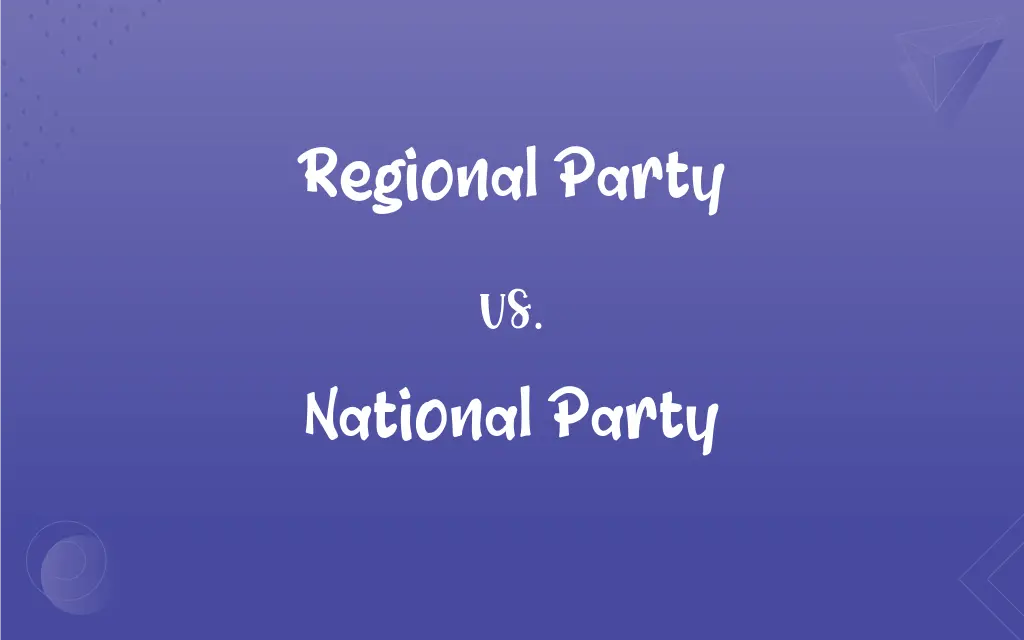Regional Party vs. National Party: What's the Difference?
Edited by Janet White || By Harlon Moss || Updated on October 26, 2023
A regional party focuses on issues specific to a particular region or state, whereas a national party addresses broader concerns spanning an entire nation.

Key Differences
A regional party typically emerges from specific geographical areas or states, representing the unique concerns, aspirations, and identities of that region. Their focus is primarily on local issues, culture, or regional autonomy. On the other hand, a national party has a presence across multiple states or regions of a country. They aim to represent the entire population and tackle issues of national importance.
In many countries, a regional party might champion a particular ethnicity, linguistic group, or regional sentiment. Such parties might contest elections only within their region or state. Conversely, a national party would contest in elections across the country, having a broader base and attempting to attract a diverse electorate.
While the goals of a regional party can sometimes clash with national interests, they play a crucial role in federal structures. They ensure that regional voices are heard and catered to. Conversely, a national party works to integrate various regional perspectives and aims for a cohesive national policy.
It's also worth noting that the scale of operations differs. Regional parties often have localized campaigns and manifestos tailored to their specific audience. In contrast, national parties run extensive campaigns and have policies that they believe cater to the broader interests of the entire nation.
Comparison Chart
Geographical Focus
Specific to a particular region or state.
Spans across the entire nation.
ADVERTISEMENT
Representation
Represents local issues, culture, or autonomy.
Represents the broader concerns of the nation.
Election Participation
Mostly contests in regional or state elections.
Contests in national and regional elections.
Support Base
Localized, often around a specific community or issue.
Broad, diverse, covering multiple regions.
Policy Scope
Localized policies and manifestos.
Comprehensive policies for national interests.
Regional Party and National Party Definitions
Regional Party
A political entity primarily addressing concerns of its specific region.
The regional party advocated for special economic measures for their state.
ADVERTISEMENT
National Party
A political group attracting a diverse electorate from various regions.
The national party's voter base comprises people from different states and backgrounds.
Regional Party
A party often rooted in regional identity or culture.
The regional party promoted the preservation of local art and traditions.
National Party
A party participating in both local and national-level elections.
The national party won a significant number of seats in both state and federal elections.
Regional Party
A group that typically participates in state or local elections.
The regional party secured a victory in the state assembly elections.
National Party
An entity aiming for a cohesive national policy.
The national party emphasized unity and integration in its campaign.
Regional Party
A political group representing a specific geographical area.
The regional party championed the rights of the local indigenous community.
National Party
A political organization with representation across a country.
The national party has branches in every major city.
Regional Party
An organization emphasizing local issues and autonomy.
The regional party's manifesto focused on improving state infrastructure.
National Party
A group addressing countrywide concerns and policies.
The national party's primary concern is improving the national education system.
FAQs
Can a regional party operate outside its specific region?
Typically, a regional party primarily operates within its designated region, but it may form alliances or extend its influence outside its primary region.
How is a regional party different from a national party?
While national parties operate on a country-wide scale and address national issues, regional parties focus primarily on regional or state-level concerns.
Why are regional parties significant?
They represent and address localized issues, ensuring diverse regional concerns are heard in national politics.
How do national parties finance their campaigns?
This varies by country but can include membership fees, private donations, state funding, and other sources.
What is a regional party?
A regional party represents interests specific to a particular region, state, or group within a country.
Why might national parties lose popularity?
Reasons can include policy failures, leadership issues, corruption, or changing public opinion.
Do regional parties influence foreign policy?
While their primary focus is regional, in coalition governments, regional parties can influence national and foreign policy decisions.
Can regional parties form coalitions with national parties?
Yes, regional parties often form coalitions with national parties to enhance their influence in national politics.
Can national parties form coalitions with regional parties?
Yes, to secure a majority in legislative bodies, national parties often form coalitions with regional parties.
How are national parties recognized?
Recognition criteria differ by country but typically involve winning a certain number of seats or percentage of votes in national elections.
Can a regional party become a national party?
If a regional party expands its influence, wins seats across multiple states, and meets certain criteria, it might be recognized as a national party.
What is a national party?
A national party operates on a country-wide scale, addressing issues and concerns that affect the entire nation.
How many national parties are typically present in a country?
This varies by country. Some nations have multiple competing national parties, while others might have two dominant ones.
Give an example of a national party.
The Democratic Party in the USA and the Conservative Party in the UK are examples of national parties.
What roles do national parties play in shaping a country's future?
They influence legislation, domestic and foreign policies, and economic strategies, thereby shaping the nation's trajectory.
Give an example of a regional party.
In India, the Telugu Desam Party (TDP) is a prominent regional party representing the state of Andhra Pradesh.
How are regional parties formed?
They are usually formed based on regional aspirations, ethnic identities, or addressing specific regional concerns.
Do national parties address regional issues?
While their primary focus is national, they do address regional issues, especially in diverse countries with varied regional concerns.
Do national parties have a fixed ideology?
While many have core ideologies, the specifics might evolve based on the political climate, public opinion, and other factors.
Do regional parties have a symbol?
Yes, like national parties, regional parties often have symbols representing their identity and ideology.
About Author
Written by
Harlon MossHarlon is a seasoned quality moderator and accomplished content writer for Difference Wiki. An alumnus of the prestigious University of California, he earned his degree in Computer Science. Leveraging his academic background, Harlon brings a meticulous and informed perspective to his work, ensuring content accuracy and excellence.
Edited by
Janet WhiteJanet White has been an esteemed writer and blogger for Difference Wiki. Holding a Master's degree in Science and Medical Journalism from the prestigious Boston University, she has consistently demonstrated her expertise and passion for her field. When she's not immersed in her work, Janet relishes her time exercising, delving into a good book, and cherishing moments with friends and family.































































